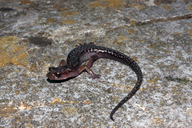|
Chiropterotriton mosaueri (Woodall, 1941)
Cave Splayfoot Salamander | family: Plethodontidae subfamily: Hemidactyliinae genus: Chiropterotriton |
 © 2018 Sean Michael Rovito (1 of 9) |
|
|
|
Description Description: Head has a truncated oval shape when viewed from above. Snout is truncate, with the upper jaw projecting beyond the lower jaw. Nares are large. Snout swollen below nostrils. Vomerine teeth are present in two curved series (13-10), with the distance separating the series equal to 2/3 the choanal diameter. Parasphenoid teeth are present in two distinct series, separated from vomerine teeth by 2x the choanal diameter, and with the series widening and diverging slightly at the posterior. Premaxillary-maxillary teeth number 31-25, and males have posterior maxillary teeth. Mandibular teeth number 34-38. Gular fold is well-defined, extending up the sides of the neck to join a median longitudinal groove. Males have a mental gland underneath the chin. Larger specimens have 12 costal grooves and smaller ones have 13 costal grooves. The costal grooves approach the dorsal midline but do not meet there, whereas they are continuous across the belly. Limbs are long; the overlap for adpressed toes is equivalent to two costal folds. Fingers are flattened. Relative finger length is 3>2>4>1, with finger I strongly reduced and fully embedded in the webbing. The tail is rounded in cross-section, has a slight constriction at the base, and is longer than the body, with the ratio of tail length to body length being 1.35. Vent is surrounded with papillae. Preserved specimens are uniformly dark brown on the dorsum and nearly uniform light tan on the venter, with only a few pigment granules visible ventrally on the chest and under the limbs and tail (Woodall 1941). Distribution and Habitat Country distribution from AmphibiaWeb's database: Mexico
Life History, Abundance, Activity, and Special Behaviors Trends and Threats This salamander was initially collected in 1937 (and described by Woodall in 1941) and was then not seen again for 73 years. It was rediscovered in September 2010 by Dr. Sean Rovito of Universidad Nacional Autónoma de México(UNAM), in an expedition funded by Conservation International as part of their "Search for Lost Frogs" campaign. It was originally classified as Critically Endangered, but its status was changed to Data Deficient in 2008 since the exact location of the original collection site was not clear (Stuart et al. 2008). Five individuals were seen in 1941 and two in 2010. The type locality is not protected although it is adjacent to the Parque Nacional Los Mármoles, and has suffered deforestation due to logging and expanding agriculture (Stuart et al. 2008). Deforestation may result in the caves drying out, eliminating habitat for this cave-dwelling species (Stuart et al. 2008). Another rare species of salamander, Chiropterotriton magnipes, was also found in the same cave. Possible reasons for amphibian decline General habitat alteration and loss Comments The specific epithet was given in honor of Dr. Walter Mosauer, a herpetologist and professor at UCLA, who specialized in the study of Mexican amphibians and reptiles. C. mosaueri was collected during his final field expedition (Woodall 1941).
References
Darda, D. M. (1994). "Allozyme variation and morphological evolution among Mexican salamanders of the genus Chiropterotriton (Caudata: Plethodontidae)." Herpetologica, 50, 164-187. [link] Stuart, S., Hoffmann, M., Chanson, J., Cox, N., Berridge, R., Ramani, P., Young, B. (eds) (2008). Threatened Amphibians of the World. Lynx Edicions, IUCN, and Conservation International, Barcelona, Spain; Gland, Switzerland; and Arlington, Virginia, USA. Woodall, H. T. (1941). ''A new Mexican salamander of the genus Oedipus.'' Occasional Papers of the Museum of Zoology, University of Michigan, 444, 1-4. Originally submitted by: Kellie Whittaker (first posted 2010-09-26) Edited by: Kellie Whittaker (2010-09-27) Species Account Citation: AmphibiaWeb 2010 Chiropterotriton mosaueri: Cave Splayfoot Salamander <https://amphibiaweb.org/species/4034> University of California, Berkeley, CA, USA. Accessed Jun 4, 2025.
Feedback or comments about this page.
Citation: AmphibiaWeb. 2025. <https://amphibiaweb.org> University of California, Berkeley, CA, USA. Accessed 4 Jun 2025. AmphibiaWeb's policy on data use. |



 Raffaëlli Account
Raffaëlli Account Map of Life
Map of Life